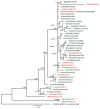Exo-Erythrocytic Development of Avian Haemosporidian Parasites in European Owls
- PMID: 36077935
- PMCID: PMC9454416
- DOI: 10.3390/ani12172212
Exo-Erythrocytic Development of Avian Haemosporidian Parasites in European Owls
Abstract
Avian haemosporidian parasites (Haemosporida, Apicomplexa) are globally distributed and infect birds of many orders. These pathogens have been much investigated in domestic and wild passeriform birds, in which they are relatively easy to access. In birds belonging to other orders, including owls (order Strigiformes), these parasites have been studied fragmentarily. Particularly little is known about the exo-erythrocytic development of avian haemosporidians. The goal of this study was to gain new knowledge about the parasites infecting owls in Europe and investigate their exo-erythrocytic stages. Tissue samples of 121 deceased owls were collected in Austria and Lithuania, and examined using polymerase chain reactions (PCR), histology, and chromogenic in situ hybridization (CISH). PCR-based diagnostics showed a total prevalence of 73.6%, revealing two previously unreported Haemoproteus and five novel Leucocytozoon lineages. By CISH and histology, meronts of several Leucocytozoon lineages (lASOT06, lSTAL5, lSTAL7) were discovered in the brains, heart muscles, and kidneys of infected birds. Further, megalomeronts of Haemoproteus syrnii (lineage hSTAL2) were discovered. This study contributes new knowledge to a better understanding of the biodiversity of avian haemosporidian parasites infecting owls in Europe, provides information on tissue stages of the parasites, and calls for further research of these under-investigated pathogens relevant to bird health.
Keywords: Strigiformes; birds; exo-erythrocytic development; haemosporidian parasites; tissue stages.
Conflict of interest statement
The authors declare no conflict of interest.
Figures



 )—meront, short black arrow (
)—meront, short black arrow ( )—cytomere, black arrowhead (
)—cytomere, black arrowhead ( )—merozoite, open arrowhead (
)—merozoite, open arrowhead ( )—intracellular young parasite stages, open arrow (
)—intracellular young parasite stages, open arrow ( )—meront containing capillary, long white arrow (
)—meront containing capillary, long white arrow ( )—erythrocytes, short white arrow (
)—erythrocytes, short white arrow ( )—host cell nucleus, white arrowhead (
)—host cell nucleus, white arrowhead ( )—wall. All scale bars are 25 µm.
)—wall. All scale bars are 25 µm.
 )—meront, short black arrow (
)—meront, short black arrow ( )—cytomere, black arrowhead (
)—cytomere, black arrowhead ( )—merozoite, open arrowhead (
)—merozoite, open arrowhead ( )—intracellular young parasite stages, long white arrow (
)—intracellular young parasite stages, long white arrow ( )—erythrocytes, short white arrow (
)—erythrocytes, short white arrow ( )—host cell nucleus, white arrowhead (
)—host cell nucleus, white arrowhead ( )—wall, asterisk (
)—wall, asterisk ( )—smooth muscle layer. Scale bars are 25 µm.
)—smooth muscle layer. Scale bars are 25 µm.
 )—meront, white arrowhead (
)—meront, white arrowhead ( )—wall. Scale bars are 25 µm.
)—wall. Scale bars are 25 µm.
 )—megalomeront, short black arrow (
)—megalomeront, short black arrow ( )—cytomere, white arrowhead (
)—cytomere, white arrowhead ( )—wall, asterisk (
)—wall, asterisk ( )—necrosis. Scale bars are 50 µm.
)—necrosis. Scale bars are 50 µm.Similar articles
-
Haemosporidioses in wild Eurasian blackbirds (Turdus merula) and song thrushes (T. philomelos): an in situ hybridization study with emphasis on exo-erythrocytic parasite burden.Malar J. 2020 Feb 12;19(1):69. doi: 10.1186/s12936-020-3147-6. Malar J. 2020. PMID: 32050970 Free PMC article.
-
Co-infecting Haemoproteus species (Haemosporida, Apicomplexa) show different host tissue tropism during exo-erythrocytic development in Fringilla coelebs (Fringillidae).Int J Parasitol. 2024 Jan;54(1):1-22. doi: 10.1016/j.ijpara.2023.07.004. Epub 2023 Aug 19. Int J Parasitol. 2024. PMID: 37598774
-
Molecular probes for the identification of avian Haemoproteus and Leucocytozoon parasites in tissue sections by chromogenic in situ hybridization.Parasit Vectors. 2019 Jun 3;12(1):282. doi: 10.1186/s13071-019-3536-2. Parasit Vectors. 2019. PMID: 31159851 Free PMC article.
-
Exo-erythrocytic development of avian malaria and related haemosporidian parasites.Malar J. 2017 Mar 3;16(1):101. doi: 10.1186/s12936-017-1746-7. Malar J. 2017. PMID: 28253926 Free PMC article. Review.
-
Keys to the avian Haemoproteus parasites (Haemosporida, Haemoproteidae).Malar J. 2022 Sep 19;21(1):269. doi: 10.1186/s12936-022-04235-1. Malar J. 2022. PMID: 36123731 Free PMC article. Review.
Cited by
-
Contribution to ecological environmental factors and the occurrence of haemosporidians in birds in Zhongar Alatau National Park, Kazakhstan.Parasitol Res. 2023 Dec 23;123(1):68. doi: 10.1007/s00436-023-08097-7. Parasitol Res. 2023. PMID: 38135737 Free PMC article.
-
Avian Haemosporidian Infection in Wildlife Rehabilitation Centres of Portugal: Causes, Consequences, and Genetic Diversity.Animals (Basel). 2024 Apr 18;14(8):1216. doi: 10.3390/ani14081216. Animals (Basel). 2024. PMID: 38672371 Free PMC article.
-
The 18S rRNA genes of Haemoproteus (Haemosporida, Apicomplexa) parasites from European songbirds with remarks on improved parasite diagnostics.Malar J. 2023 Aug 10;22(1):232. doi: 10.1186/s12936-023-04661-9. Malar J. 2023. PMID: 37563610 Free PMC article.
-
Host Cells of Leucocytozoon (Haemosporida, Leucocytozoidae) Gametocytes, with Remarks on the Phylogenetic Importance of This Character.Pathogens. 2023 May 13;12(5):712. doi: 10.3390/pathogens12050712. Pathogens. 2023. PMID: 37242382 Free PMC article.
-
A Four-Year Survey of Hemoparasites from Nocturnal Raptors (Strigiformes) Confirms a Relation between Leucocytozoon and Low Hematocrit and Body Condition Scores of Parasitized Birds.Vet Sci. 2023 Jan 12;10(1):54. doi: 10.3390/vetsci10010054. Vet Sci. 2023. PMID: 36669055 Free PMC article.
References
-
- Valkiūnas G., Atkinson C.T. Introduction to life cycles, taxonomy, distribution, and basic research techniques. In: Santiago-Alarcon D., Marzal A., editors. Avian Malaria and Related Parasites in the Tropics: Ecology, Evolution and Systematics. Springer Nature; Cham, Switzerland: 2020. pp. 45–80. - DOI
-
- Valkiūnas G. Avian Malaria Parasites and Other Haemosporidia. CRC Press; Boca Raton, FL, USA: 2005.
Grants and funding
LinkOut - more resources
Full Text Sources

